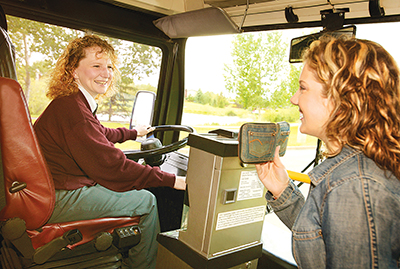
![]() BUSRide spoke with experts in the fare system industry to hear their thoughts on the current state of fare collection, notable trends and projections for the future. This roundtable discussion featured the following panelists:
BUSRide spoke with experts in the fare system industry to hear their thoughts on the current state of fare collection, notable trends and projections for the future. This roundtable discussion featured the following panelists:
Darren Dickson, president – Genfare
Jordan Medlin, senior product manager – INIT
How important is it for transit systems to provide mixed fare options for their customers? Why?
Darren Dickson: Customer convenience is one of several driving factors in retaining riders and ridership growth. By embracing the new technologies available in fare collection systems today, including mixed fare options, an agency can guarantee that they will be able to provide the most convenient and economical fare options for their passengers. By allowing fare payment by smart cards, mobile phones, magnetic stripe cards/tickets or cash, agencies can ensure their passengers of having the right fare product for all of their diverse riders. Different fare payment options appeal to different ridership groups. Public transportation is competing with more and different types of mobility options – transit must make sure it stays at the forefront of technology.
Jordan Medlin: Transportation is a public service, therefore transit agencies have an obligation to provide the widest array of payment options for their customer base. Patrons want to use what is convenient for them. Whether it’s the mobile-demand of millennials, the vital necessity of paratransit payment options for the elderly and disabled, or the need for simplicity and routine payment methods for the average daily rider, a diverse fare system is essential to the success of any transit system. A key necessity for public transportation is to remove any obstacles to ride. A daily commuter who relies on public transportation to get to and from work knows how they will pay, and for most, the buying process is largely an afterthought. A tourist who wants to get the true feeling of the city may opt to venture out and experience the city through the eyes of a “local”. Both riders are of equal importance, yet the buying experience may be holistically different.
To what degree are North American transit systems adopting mobile payments? To what degree are passengers utilizing them?
Dickson: Mobile payment options are a very hot topic in transit today. The use of mobile continues to increase and be embraced by many sectors of the North American population, and transit needs to stay abreast of this evolving trend. Millennials, a population group that transit is very interested in capturing as riders, are especially comfortable with using their phones for everything. However, this is only a part of the fare payment solution. As previously noted, it is important to offer passengers a wide range of fare options to ensure that you appeal to all groups.
Passenger utilization rates vary from agency to agency. In other areas of the world where mobile ticketing is well established, average utilization rates range from five to ten percent. Some North American cities are seeing some higher and some lower rates than these more established cities. Many transit-dependent riders and regular commuters may find other fare payment methods more cost-effective and just as convenient.
Medlin: Mobile payments are no longer the future. They are the present. Most modern fare payment and/or management procurements require some kind of mobile application. Specifically, enabling the convenience of platform and onboard payments reduces a substantial barrier to entry, especially to the younger generation of riders, for whom convenience is a must. Additionally, attracting these young, environmentally-conscious riders can help ensure the viability of a transit system in the long term. These passengers are far more likely to ride public transit than their parents are/were, but will not do so if they find it inconvenient.
Are open payments and account-based payments destined to be the “new normal” in public transit?
Dickson: For large transit agencies, open payment and account-based systems are beginning to emerge. Open payment systems allowing the use of credit cards can expand as the technology and communications connectivity matures. Account-based systems rely on this same technology and communications connectivity. As systems evolve and stabilize, it is expected that they will become more cost effective. The real challenge will be to extend these systems to mid-size and smaller size transit operations at an affordable cost. This is an area that Genfare is especially interested in and making great progress at delivering to the marketplace.
Medlin: Unequivocally yes. Account-based systems enable the convenience of back-end account management, which reduces costs to riders, specifically in card values. In account-based systems, cards need to be less sophisticated, since the sophistication exists on the back end. This makes cards cheaper, for agencies and, by extension, passengers. They also provide improved security and convenience; since balances do not exist on the card, one need only activate a new card on the account and the balance remains. Lost cards no longer mean lost fare balances.
Sooner rather than later, we will see the industry move to the prevalence of open payment systems. While adding a layer of complexity to any fare system, open payments provide a convenience that consumers of all industries want and demand. Moreover, as the technology has matured, so too have the security measures. As a result, consumers are less concerned with the viability of security measures in place for these technologies. Simply put: the technology is available, viable and more affordable than ever.
In what ways must transit agencies – and thus TVM providers – remain cognizant of the ADA as it relates to fare collection?
Dickson: As fare collection system suppliers, we must all be aware of ADA requirements as we design our products. We want to make sure that our designs use the best possible combination of functionality, ease of use for all passengers and convenience. We, and our agency partners, are required to provide equipment that is compliant with the ADA laws and regulations, so we design with this in mind. We strive to incorporate the latest in audio, visual and other technologies to make it easy for all passengers to use – especially those who are physically challenged.
Medlin: The good news is that in the nearly 30 years since the Americans with Disabilities Act was passed, ADA compliance has become both a financial and moral imperative. By combining the ethical reasons with the financial reasons, industries across the board have come to the realization that not only is ADA compliance the right thing to do, it’s also a potentially profitable endeavor. As a result, hardware providers of all stripes have catered a specific segment of their development to, not only meet the requirements, but find ways to exceed them.
Specifically, for riders of low or no vision, touchscreen displays can be problematic because you can’t put brail on an LCD touchscreen. That’s one specific area in which transit agencies and hardware providers need to remain vigilant as the technology matures and saturates markets. Additionally, ADA height restrictions are an important area of observation. Especially as TVMs continue to mature and the technology miniaturizes, it will remain important that disabled passengers have access to the full functionality of the TVM.
How can fare collection technology contribute to a better public perception of transit?
Dickson: We can enhance the public perception of transit by delivering a simple and easy-to-use rider experience for the fairest price possible. Fare collection systems should be intuitive and user-friendly, and they should allow for seamless mobility across all transport modes. As mobility options become more connected, we want systems that will make the user experience pleasant and convenient. Bus, rail, bike and car share, Uber and Lyft all have a place in the mobility solutions of the future. That’s where Genfare is headed.
Medlin: Fare collection may be the best tool in an agency’s tool belt to make transit more attractive. What component of the transit process has the most customer access? The ability to provide a diverse, technologically relevant and convenient payment methodology is a fantastic tool to demonstrate to passenger that an agency is modern, affordable, customer-focused and provides a desirable transportation alternative.
What will fare collection look like in 5 years? 10 years?
Dickson: Fare collection will change dramatically as public transit moves from bus and train operators to mobility managers. The future holds great promise for a more connected mobility platform, which offers a variety of options and choices available to the riding public. Fare collection systems can unite all forms of mobility management and give the user the greatest number of alternatives to meet their travel needs.
Medlin: Don’t be surprised to see the overwhelming majority of transit transactions occurring on mobile devices. The market for mobile-based payment systems like Android Pay, Apple Pay, Google Wallet, Visa Checkout, Master Pass, etc. is going to continue to grow. This growth will be from new consumers who have less concerns about security and viability as those products mature. Agencies that have the ability to accept payments onboard and at platforms for these applications will be able to attract more passengers. Additionally, with some vendors and agencies exploring the capabilities of Bluetooth, including BLE “zones” (a convenient, but undeveloped, way to tap on/off without having to wait in lines – simply walk through a “zone” and your fare is debited via mobile app or payment app upon leaving the “zone” as a tap off), we believe that the convenience of mobile payments will become ubiquitous in our industry.

